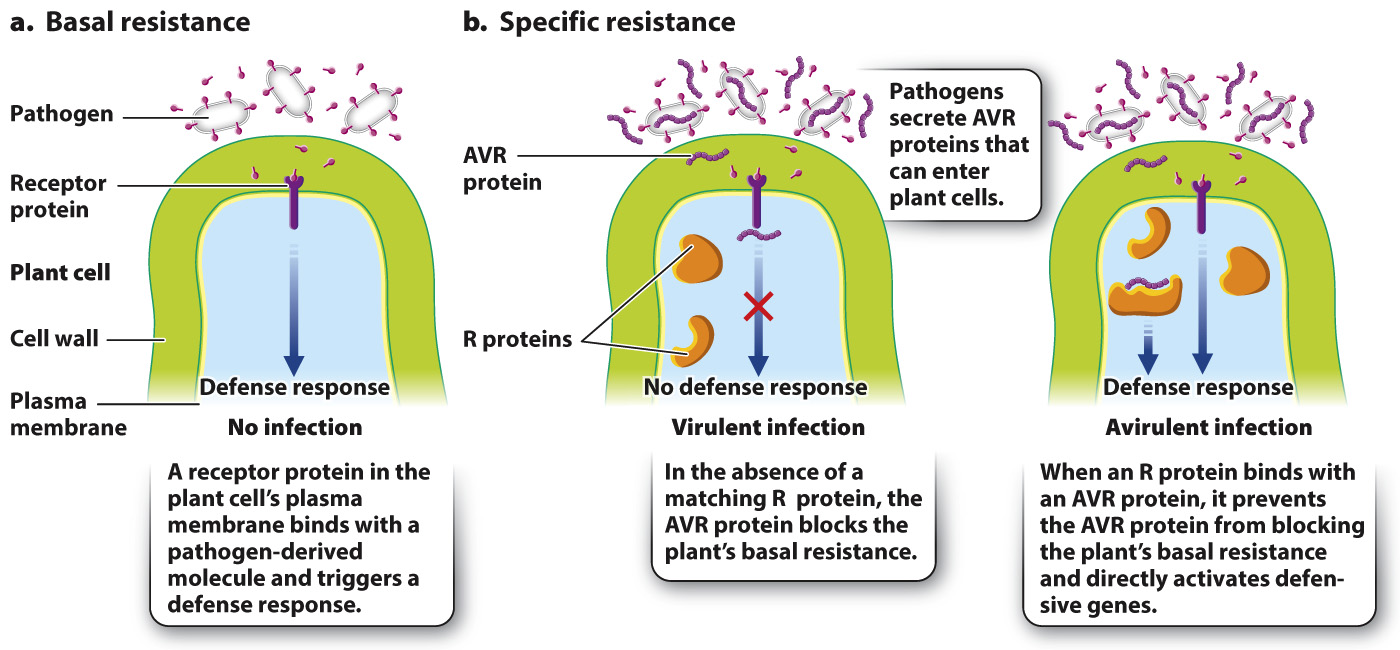Plants are able to detect and respond to pathogens.
Most plants are at risk of infection by only a small subset of the many known plant pathogens. Host plants of a particular pathogen are the species that can be infected by that pathogen. Not all infections significantly damage the host plant, however. Virulent pathogens can overcome the host plant’s defenses and lead to disease. In contrast, avirulent pathogens damage only a small part of the plant because the host plant is able to contain the infection. Whether an interaction is virulent or avirulent depends on the genotypes of both the pathogen and the host plant.
In your own body, the innate immune system provides a first line of defense against pathogens (Chapter 43). Plants, too, have an immune system that allows them to detect pathogens and mount an appropriate response. A key feature of the immune system is that plants, like animals, can recognize a cell or virus as foreign. How do they accomplish this?
Plant cells have protein receptors (Chapter 9) that bind to molecules produced by pathogens and recognize them as foreign to the plant body. Binding changes the conformation of the receptor, triggering a cascade of reactions that enhance the plant’s ability to resist infection.
The plant immune system has two components (Fig. 32.4). The first consists of receptors located on the plasma membrane (Fig. 32.4a). These receptors recognize highly conserved molecules generated by broad classes of pathogens. Examples of these molecules are flagellins, present in the flagella of bacteria, and chitin, a component of the fungal cell wall. When one of these molecules binds to the plant’s receptor, an array of defense mechanisms is triggered that help protects the plant from infection. Protection from pathogens conferred by this component of the immune system is called basal resistance.

The second component of the plant immune system allows plants to resist pathogens that have evolved means of overcoming basal resistance. Pathogens produce proteins called AVR proteins that enter into plant cells and facilitate infection (“AVR” stands for “avirulence”). Some AVR proteins block defense responses triggered by the basal resistance of plants, while others cause the cell to secrete molecules that the pathogen needs to support its own growth. The second component of the plant immune system targets these AVR proteins.
Like basal resistance, this component of the immune system also consists of receptors, but in this case they are located inside the cell rather than on the plasma membrane (Fig. 32.4b). Plants harbor hundreds of these receptors, called R proteins, each expressed by a different gene—
The large number of R genes is the result of an evolutionary arms race that occurs as pathogens evolve ways to evade their host’s detection systems. Pathogens improve their success rate when mutation results in an AVR protein that does not bind with any of the R proteins produced by its host plant. For example, P. infestans, the pathogen responsible for the Irish potato famine, produces many more AVR proteins than related Phytophthora species. The large number of AVR proteins found in P. infestans increases the probability that at least one of these proteins is not detected by the infected plant. Conversely, when pathogens are successful, natural selection favors plant populations that produce new R proteins capable of binding to the AVR proteins of the invader.
Quick Check 1 Can the specific component of the plant immune system (the one using R genes) defend against both biotrophic and necrotrophic pathogens?
Quick Check 1 Answer
No. The component of the plant immune system that uses R genes can defend only against biotrophic pathogens, not necrotrophic ones, because this component of the immune system is based on receptor molecules within living cells. Necrotrophic pathogens kill cells before colonizing them.